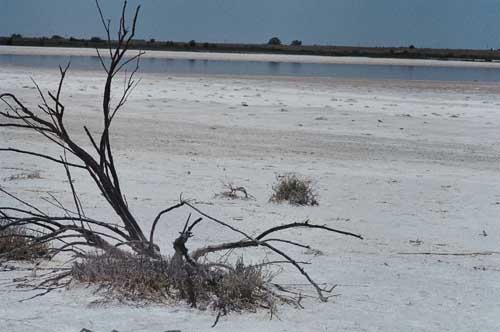
|
Further Notes on the Diatoms of Bitter Lake National Wildlife Refuge, Chaves County, New Mexico
by David B.
Richman, |
Bitter Lake National Wildlife Refuge lies a few kilometers north east of Roswell, New Mexico, along the Pecos River. The unique geological history of the area resulted in soils high in gypsum and also a localized flora of gypsum adapted plants. While almost every plant you examine looks at first like something familiar, this familiarity often drops off when the plant is examined closely. The main body of water is Bitter Lake itself; a playa lake that is not very deep, but usually contains some water. The water becomes more salty as evaporation occurs. This past June the lake was low because of drought (the Refuge had not had much measurable rain since last October) and the halophilic Archaea had colored the mud along the edge of the water a dull pink.

Bitter Lake in early June 2006, after seven to eight months of drought. The dirty pinkish caste to the mud along the lake edge is caused by halophilic bacteria. The white color to the foreground is caused by gypsum in the soil. The lake is both salty and somewhat alkaline.
While I had sampled the lake earlier when overflow ponds allowed me access, I found the mud now to be covered with a thin crust that almost immediately gave way to an odiferous jelly-like under layer. I did sample some more sinkholes and sent the samples on to the California Academy of Science for processing. I cannot say much about the results because they are not yet in, but I can offer some observations on diatoms collected from the overflow ponds and several sinkholes during the last year (March 2005) based on samples I took then, which were processed by Jim Soliday and also at the California Academy of Sciences and sent back to me on permanent slides. These proved most interesting.
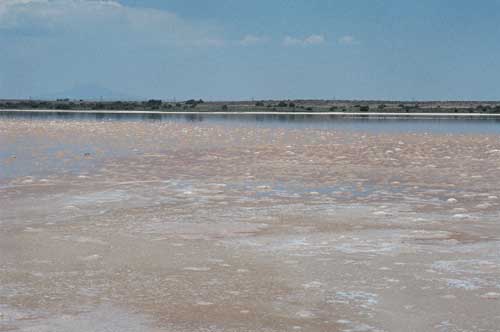
Bitter Lake in early June 2006. A closer look at the dull pink colonies of halophilic Archaea bacteria.
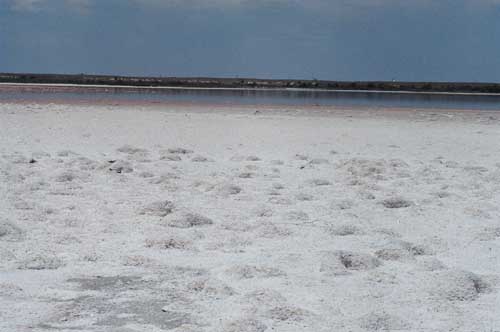
Bitter Lake in early June 2006. Gypsum mounds near beach of lake.
Earlier (Micscape, December 2004) I made some general observations on diatoms from the overflow ponds, but could only say “Synedra” sp. or “naviculoid” diatoms. Now I have been able to identify some genera and species at least tentatively and I present here some of these results.
Probably one surprise was that many of the rod-like diatoms turned out to be a Nitzschia, possibly sigmoidea. There were many of these slender slightly s-shaped diatoms from the Bitter Lake samples. There were also the rod-like Synedra that I had noted earlier. Another find was the saline lake species Campylodiscus clypeus. This is a large diatom (over 100 microns) that is known from the western United States, but from other diverse places as well, such as Mongolia and Senegal. The diatom is shaped to a large degree like a potato chip (see photo below). Other diatoms found were probably in the genera Synedra and Navicula.
.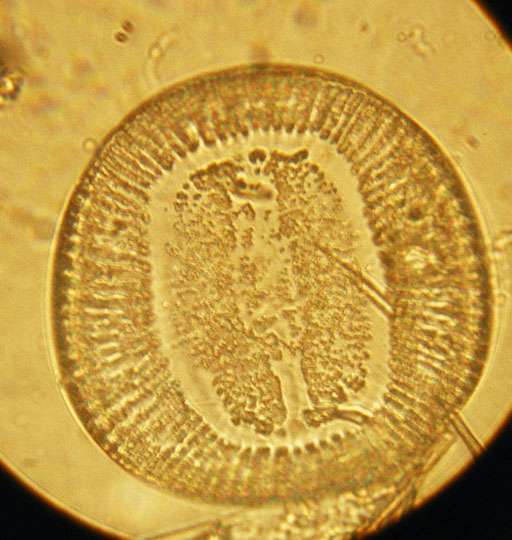
Campylodiscus clypeus from Bitter Lake overflow pond taken
with a Nikon FM2n and Agfa 200 ISO film at 430X with apocromatic 43X
objective
on a 1941 Spencer binocular compound microscope.
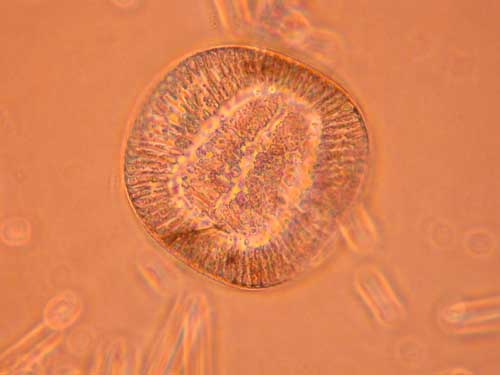
Campylodiscus clypeus (another specimen) at 200X taken with a digital Nikon Coolpix 995 and a Parco-Meiji phase contrast microscope.
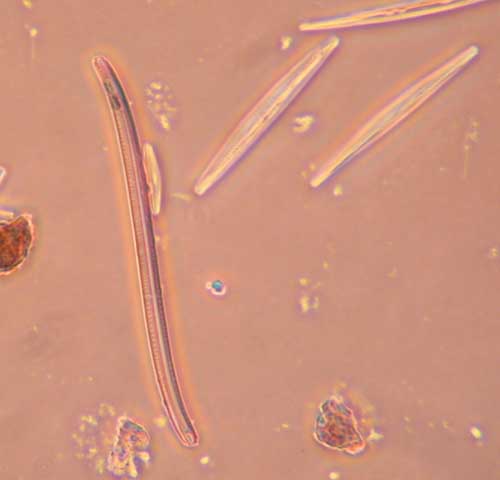
Nitzschia sp. (sigmoidea?) (at left) at 200X taken with a digital Nikon Coolpix 995 and a Parco-Meiji phase contrast microscope.
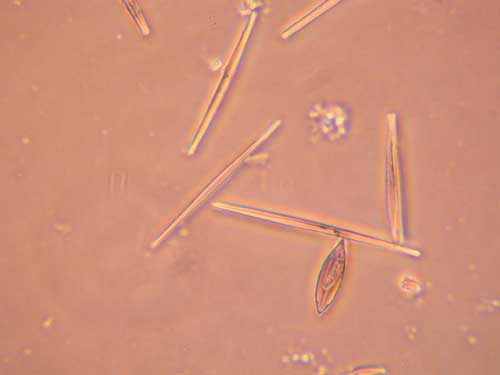
Synedra sp. ? (rod-like diatoms) at 200X taken with a digital Nikon Coolpix 995 and a Parco-Meiji phase contrast microscope.
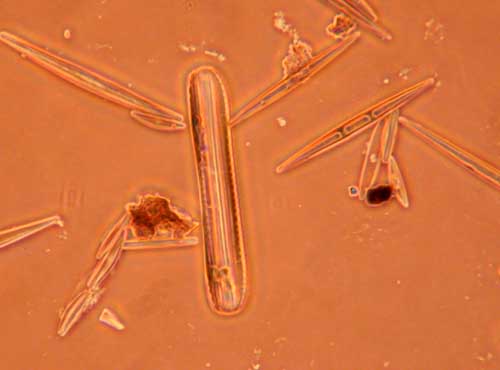
Probably girdle view of either Nitzschia or Hantzschia
(just left of center) at 200X
taken with a
digital Nikon Coolpix 995 and a Parco-Meiji phase contrast
microscope.
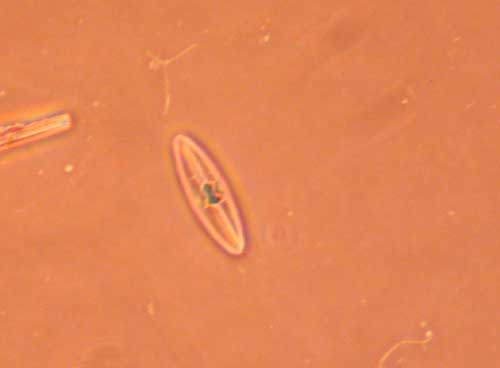
Achnanthes sp. ? at 200X taken with a digital Nikon Coolpix 995 and a Parco-Meiji phase contrast microscope.
Another discovery was that one of the sinkhole samples (Sinkhole #20) was full of Cyclotella, a genus I have yet to find in the Bitter Lake overflow ponds, plus several other genera that I had not seen before. Below is a sampling from this sinkhole.
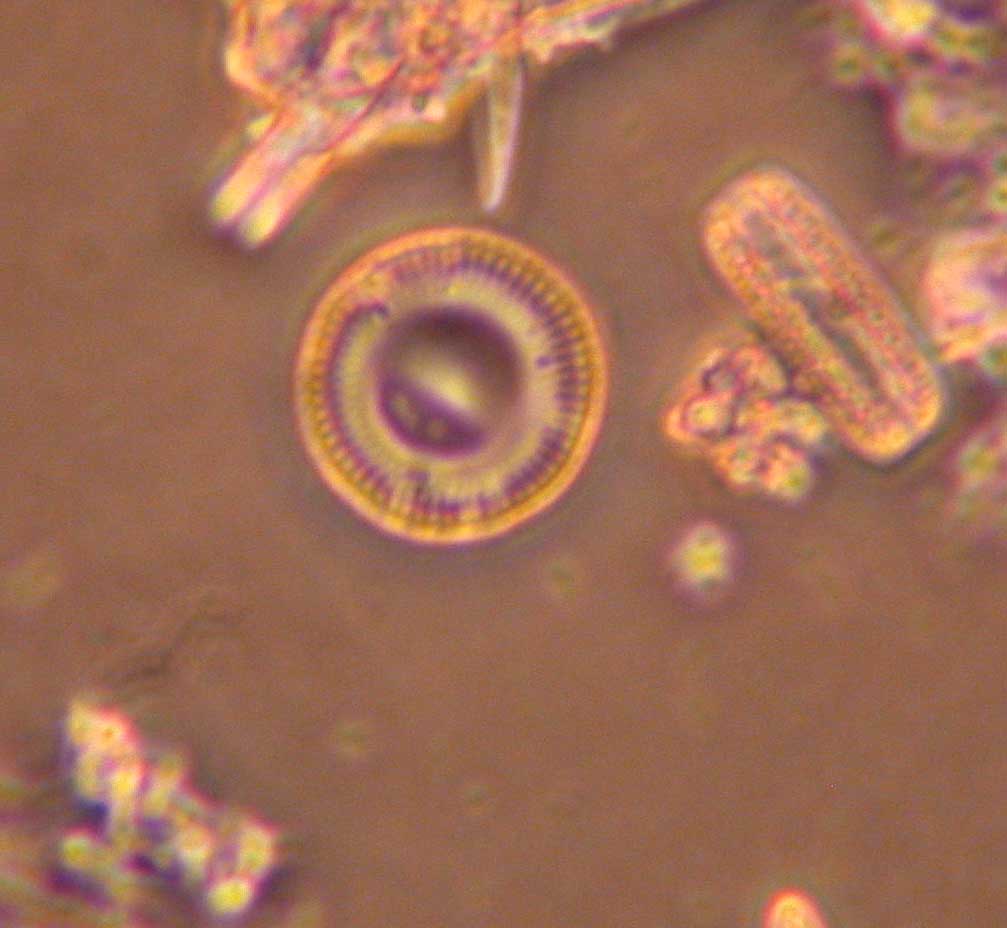 .
.
Cyclotella sp. from Sinkhole #20 at 400X taken with a digital
Nikon Coolpix 995 and a Parco-Meiji phase contrast microscope.
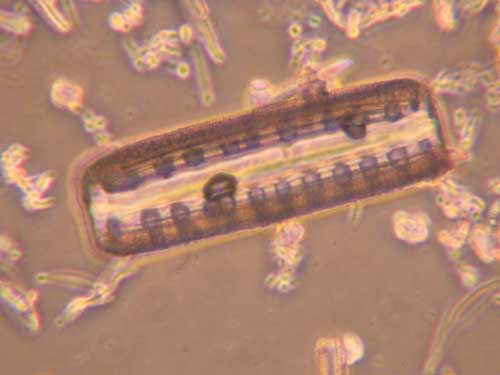
Diatom (Epithemia sp. ?) from Sinkhole #20 at 400X taken with a digital Nikon Coolpix 995 and a Parco-Meiji phase contrast microscope.
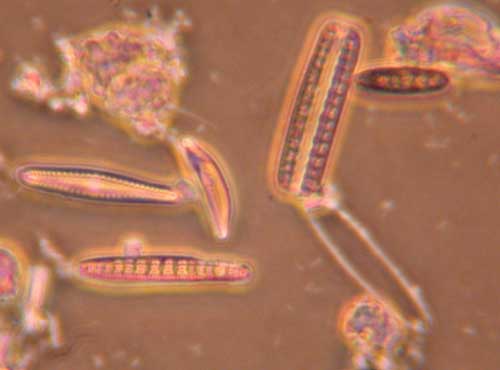
Diatoms from Sinkhole #20 at 200X taken with a digital Nikon Coolpix 995 and a Parco-Meiji phase contrast microscope.
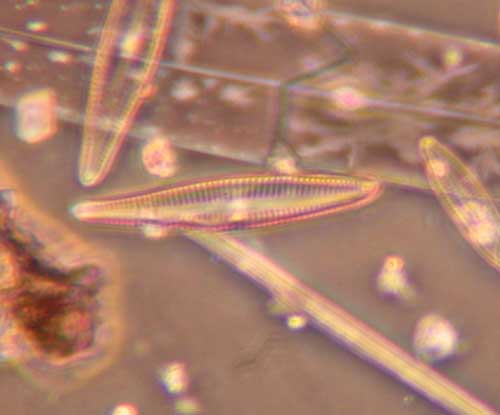
Diatoms from Sinkhole #20 at 400X taken with a digital Nikon Coolpix
995 and a Parco-Meiji phase contrast microscope.
The large diatom in
the background top is apparently a Pleurosigma species.
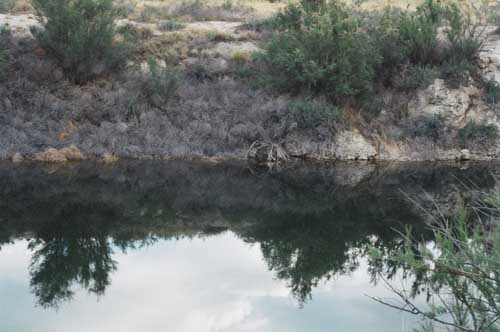
I believe that this is Sinkhole #3 (north of Bitter Lake.) This is one of over 60 sinkholes, some of which were dry (sinkhole #2 for example) when I last visited the area..
Thanks to the Fish and Wildlife Service and especially to Gordon Warrick for allowing access to the lake and sinkholes, to Jim Solliday (Bitter Lake samples) and to the California Academy of Sciences (Sinkhole #20 samples) for the prepared slides from my material collected, and to Robert McLaughlin, who gave me the Spencer microscope and who confirmed some of my identifications.
Note: If anyone can give me an idea as to what other genera the unknown diatoms on these photos belong or can confirm or refute the tentative identifications I have made, please contact me. I am relatively new to this work and need all the help I can get!
Update Oct. 26th. A thank you to Frithjof Sterrenburg in The Netherlands who offered some corrections to my tentative identifications.
Comments to the author, David Richman, are welcomed.
References:
Czarnecki, D. B., and D. W. Blinn. 1978. Diatoms of the Colorado River in Grand Canyon National Park and Vacinity. Bibliotheca Phycologica 38: 1-181.
Deby, J. 1891 (no date on title page). Analysis of the Diatomaceous Genus Campylodiscus. London. Privately published, 96 pp, plus 15 plates.
Hartley, B. 1996. An Atlas of British Diatoms. Biopress, Bristol, Great Britain, 601 p.
Richman, D. B. 2004. Further Notes on the Microorganisms of Bitter Lake Sinkholes. Micscape, December 2004.
Vinyard, W. C. 1979. Diatoms of North America. Mad River Press, Eureka, California, 119 p.
Wolle, F. 1894. Diatomaceae of North America. Comenius Press, Bethlehem, Pennsylvania, 47 p., plus 111 pls.
Please report any Web problems or offer general comments to the Micscape Editor.
Micscape is the on-line monthly magazine of the Microscopy UK web site at Microscopy-UK.